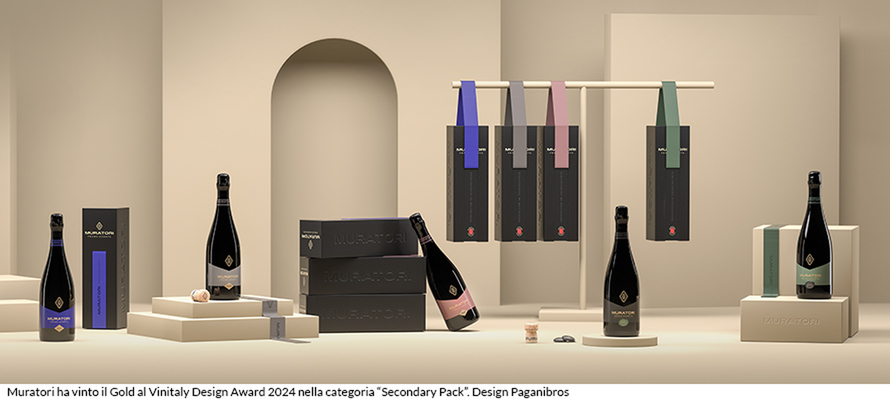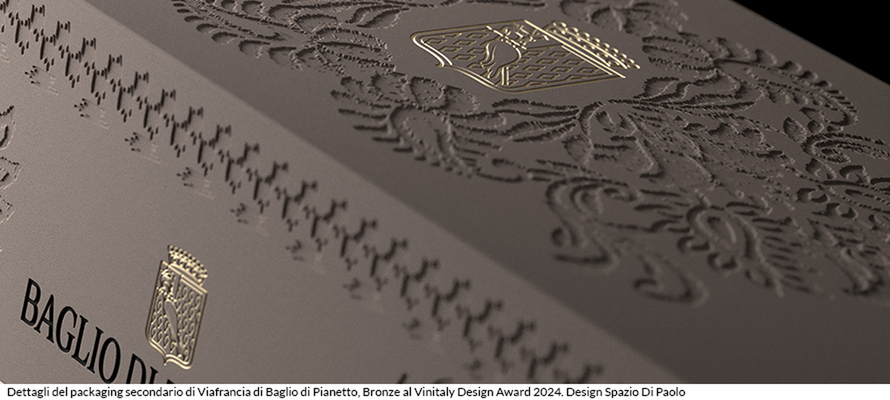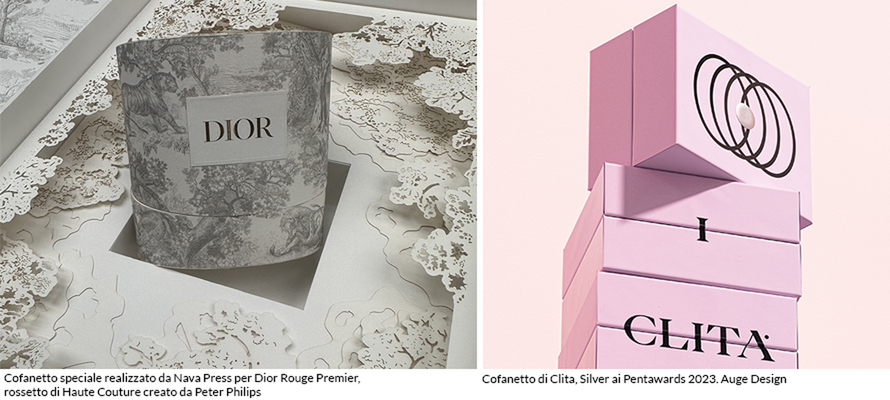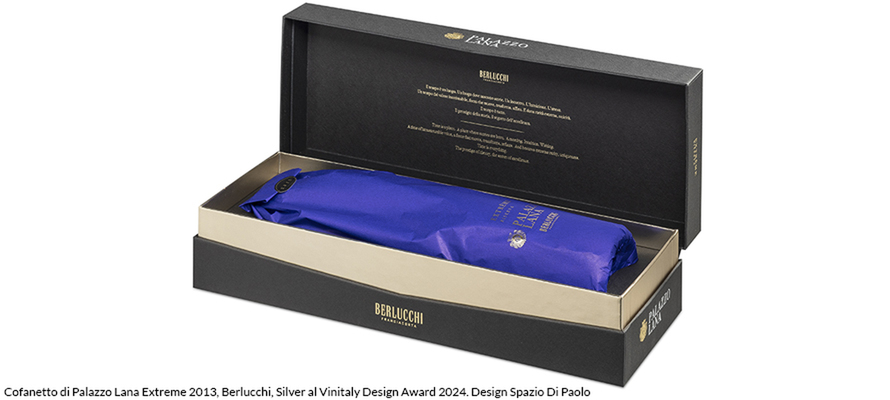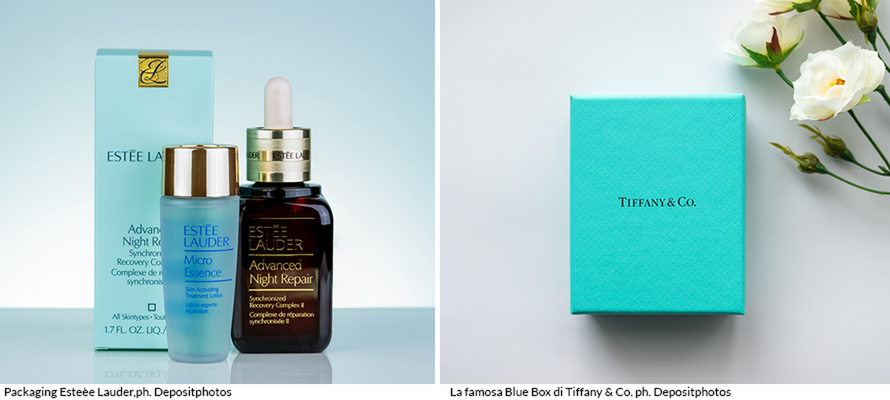Unwrapping the enchantment: the new values of luxury packaging
We already know that high-end is distinguished by a special relationship with its public. In addition to guaranteeing product quality, it should be able to promise and gift emotions, gestures, and storytelling. An emotional journey in which packaging continues to represent a fundamental touchpoint: this is why research never stops.
By Valeria Sanna | On PRINTlovers 102
The unboxing experience is a fundamental moment in the relationship between the brand and its end customer; it is increasingly the first interaction the consumer has with the product, and everything - the design, the feel, the aesthetics - should convey a sense of superior quality and class and involve the consumer in an exclusive and personal experience: the expectations of luxury customers are very high. In the background is a scenario in which there has been a further significant increase in online commerce, a phenomenon that has also extensively involved the luxury sector, reinforcing the importance of being able to guarantee a unique and memorable unboxing experience.
Green Luxury
In recent years, the growing awareness around environmental issues has led legislators to establish increasingly stringent regulations - the European Parliament and the EU Council recently confirmed the new directive aiming to reduce packaging waste in member states by 15% by 2040 - and at the same time has prompted consumers to increasingly direct their preferences towards brands that express environmentally oriented values.
Generation Z, new audience, new values
Bain & Company, in its annual analysis for Fondazione Altagamma published in January 2024, investigated the market and the performance of more than 280 leading companies and brands in the luxury segment and found that, together with the Millennials (born between 1981 and 1996), Generation Z (1996-2010) drove the entire growth of the luxury sector in 2022, and expects to account for 70% of buyers by 2025, contributing to a radical transformation of the sector.
The more mature generation, Generation X (1965-80), is now at the peak of its income and will still represent a significant slice of the market for a few years, but Millennials and especially Generation Z consumers, have a very mature inclination towards luxury and their purchases start three to five years earlier than those of previous generations; the study estimates that by 2030, Gen Z will make between 25% and 30% of luxury goods purchases, Millennials between 50% and 55%.
According to another recent meta-analysis study (Honors Tutorial College, Ohio) investigating perceived value in luxury packaging, luxury market consumers will grow from 400 million to 500 million over the next five years, with Generation Z accounting for more than a third of these new consumers.
Sustainability versus Brand
The future of brands lies in going beyond the traditional notion of luxury and succeeding in increasingly reflecting the values and needs of this new group of consumers: inclusiveness, transparency, innovation, circularity and, above all, environmental sustainability. The value of sustainability has become a critical factor in attracting and retaining consumers, the youngest of whom have no doubt: sustainability predominates over brand recognition and appreciation.
A few months ago, Positive Luxury published its report on the return on investment in sustainability. The report investigated, among other things, the importance consumers attach to the concept of 'brand' as opposed to 'sustainability' by asking participants from different age groups which factor most influenced their decision to purchase. All groups placed a higher importance on sustainability, the delta between the two factors increasing to 26 points for Generation Z, who gave a rating of 49% for brand name and 75% for sustainability.
Against this backdrop of growth and renewal, Future Market Insights estimates the global luxury packaging market in 2023 at $10.4 billion and expects it to grow to $17.9 billion by 2033, while according to the Buying Green Report 2023 by Trivium Packaging and Euromonitor International, 79% of consumers, more than 9000 respondents, look for products in sustainable packaging and 63% say they are less likely to buy products with environmentally harmful packaging.
The figures are impressive, but the arithmetic is simple: new generations of consumers are increasingly decisive for the Luxury market and show an ever-increasing environmental awareness. Packaging is a player in the relationship with these consumers and their expectations of respect for the environment, and any growth objective for companies moving into this market should put sustainability centre stage and at the heart of their choices.
Today, the demand for environmentally friendly packaging solutions is higher than ever in the industry, and the most exclusive brands and their suppliers are in the best position to drive the change towards sustainability. Longevity and reusability, for example, are already among the most valued attributes of Luxury products, and this is an advantage perfectly in line with environmental goals. Another big push is represented by a target group that is sensitive to environmental issues and, at the same time, economically very open. This prerogative has allowed luxury brands to be at the forefront of this transition and to experiment with materials and techniques that are not as accessible to those producing for other segments.
The solutions are increasingly numerous and creative, with some brands experimenting with new minimalisms in a mono-material key. They retain a sophisticated look and feel without incorporating different or incompatible materials into the recycling chain.
Bioplastics are another possibility attracting great attention in the sector, as is the return to using glass and metal to replace plastic elements. Aluminium, in particular, has seen a great return of interest and investment thanks to its aesthetic and functional characteristics, almost infinite recyclability and durability, and the possibility of being collected and reprocessed through established logistics and production chains, with good options for establishing circularity practices.
Another field in constant renewal in the Luxury Packaging field is that of inks. There is great interest in inks based on bio-renewable molecules, such as inks formulated with soya oil, resins, waxes and solvents derived from organic material or pigments derived from algae to replace carbon-based blacks. In general, the industry is moving towards inks formulated in such a way as to have the lowest possible environmental impact both during production and release into the environment. In the case of algae, it is even negative due to their ability to absorb CO2 during cultivation.
Innovative eco-design approaches
The evolution towards sustainable luxury extends beyond the choice of materials to revolutionise the entire packaging design. This influences the way products are offered by the brand and experienced by the end consumer, while more efficient and flexible production is becoming a reality thanks to digital and hybrid printing.
Luxury packaging is no longer just a means to create visual and sensory impact: ecological form and function are married by incorporating innovative concepts, such as reusable elements, modular structures or printed packaging with special die-cuts that allow it to be reconfigured for new uses - even packaging made of biodegradable material containing seeds that can be cultivated to produce flowers and plants, which is an exciting possibility for products based on plant and flower extracts, not only in the beauty sector. These innovations add a level of functionality beyond the first use, demonstrate the brand's dedication to waste reduction, engage with the consumer in a relationship that goes beyond the nature of the product itself and, at the same time, promote new levels of business and new partnerships in packaging design and production. As the concept of Green Luxury becomes increasingly popular, new opportunities for creativity, new horizons for experimentation and new market possibilities throughout the packaging sector are opening up in a traditionally rather staid and hard-to-shake industry.
Estèe Lauder, Tiffany & Co. and Bruichladdich, for example
When we talk about Tiffany & Co., we’re talking about a brand and packaging that are one in the collective imagination. The famous, timeless Blue Box has spanned decades and is now dealing with the test of sustainability without flinching. The company has committed to using 100% sustainable material to produce the Blue Boxes, hoppers, marketing support material and catalogues. From 2022, Tiffany will produce its packaging with more than 65% recycled materials, and its sustainability targets include eliminating single-use plastic by 2025. In an initiative that also focuses on awareness and engagement with its audience, starting in 2023, the brand will offer the option of reduced and innovative packaging at the time of purchase.
In the world of spirits, Islay distiller Bruichladdich has introduced new packaging for its finest single malt, The Classic Laddie, focusing on sustainability. The bottle contains 60% recycled glass and is 32% lighter than the previous version. The characteristic aquamarine colour of the coating is achieved with an organic ink, while the closure and cap are made of biobased polypropylene. But one of the most surprising news items is not something new, but something missing: the new Classic Laddie is sold without a tin. By completely renouncing secondary packaging, the Scottish manufacturer has reduced the CO2 emissions of its product by 65%. A bold choice, given that tins and pipes are traditionally associated with high quality in the spirits world, but consumers appreciate strong sustainability choices and often reward the brave.
By Valeria Sanna | On PRINTlovers 102
The unboxing experience is a fundamental moment in the relationship between the brand and its end customer; it is increasingly the first interaction the consumer has with the product, and everything - the design, the feel, the aesthetics - should convey a sense of superior quality and class and involve the consumer in an exclusive and personal experience: the expectations of luxury customers are very high. In the background is a scenario in which there has been a further significant increase in online commerce, a phenomenon that has also extensively involved the luxury sector, reinforcing the importance of being able to guarantee a unique and memorable unboxing experience.
Green Luxury
In recent years, the growing awareness around environmental issues has led legislators to establish increasingly stringent regulations - the European Parliament and the EU Council recently confirmed the new directive aiming to reduce packaging waste in member states by 15% by 2040 - and at the same time has prompted consumers to increasingly direct their preferences towards brands that express environmentally oriented values.
Generation Z, new audience, new values
Bain & Company, in its annual analysis for Fondazione Altagamma published in January 2024, investigated the market and the performance of more than 280 leading companies and brands in the luxury segment and found that, together with the Millennials (born between 1981 and 1996), Generation Z (1996-2010) drove the entire growth of the luxury sector in 2022, and expects to account for 70% of buyers by 2025, contributing to a radical transformation of the sector.
The more mature generation, Generation X (1965-80), is now at the peak of its income and will still represent a significant slice of the market for a few years, but Millennials and especially Generation Z consumers, have a very mature inclination towards luxury and their purchases start three to five years earlier than those of previous generations; the study estimates that by 2030, Gen Z will make between 25% and 30% of luxury goods purchases, Millennials between 50% and 55%.
According to another recent meta-analysis study (Honors Tutorial College, Ohio) investigating perceived value in luxury packaging, luxury market consumers will grow from 400 million to 500 million over the next five years, with Generation Z accounting for more than a third of these new consumers.
Sustainability versus Brand
The future of brands lies in going beyond the traditional notion of luxury and succeeding in increasingly reflecting the values and needs of this new group of consumers: inclusiveness, transparency, innovation, circularity and, above all, environmental sustainability. The value of sustainability has become a critical factor in attracting and retaining consumers, the youngest of whom have no doubt: sustainability predominates over brand recognition and appreciation.
A few months ago, Positive Luxury published its report on the return on investment in sustainability. The report investigated, among other things, the importance consumers attach to the concept of 'brand' as opposed to 'sustainability' by asking participants from different age groups which factor most influenced their decision to purchase. All groups placed a higher importance on sustainability, the delta between the two factors increasing to 26 points for Generation Z, who gave a rating of 49% for brand name and 75% for sustainability.
Against this backdrop of growth and renewal, Future Market Insights estimates the global luxury packaging market in 2023 at $10.4 billion and expects it to grow to $17.9 billion by 2033, while according to the Buying Green Report 2023 by Trivium Packaging and Euromonitor International, 79% of consumers, more than 9000 respondents, look for products in sustainable packaging and 63% say they are less likely to buy products with environmentally harmful packaging.
The figures are impressive, but the arithmetic is simple: new generations of consumers are increasingly decisive for the Luxury market and show an ever-increasing environmental awareness. Packaging is a player in the relationship with these consumers and their expectations of respect for the environment, and any growth objective for companies moving into this market should put sustainability centre stage and at the heart of their choices.
Today, the demand for environmentally friendly packaging solutions is higher than ever in the industry, and the most exclusive brands and their suppliers are in the best position to drive the change towards sustainability. Longevity and reusability, for example, are already among the most valued attributes of Luxury products, and this is an advantage perfectly in line with environmental goals. Another big push is represented by a target group that is sensitive to environmental issues and, at the same time, economically very open. This prerogative has allowed luxury brands to be at the forefront of this transition and to experiment with materials and techniques that are not as accessible to those producing for other segments.
The solutions are increasingly numerous and creative, with some brands experimenting with new minimalisms in a mono-material key. They retain a sophisticated look and feel without incorporating different or incompatible materials into the recycling chain.
Bioplastics are another possibility attracting great attention in the sector, as is the return to using glass and metal to replace plastic elements. Aluminium, in particular, has seen a great return of interest and investment thanks to its aesthetic and functional characteristics, almost infinite recyclability and durability, and the possibility of being collected and reprocessed through established logistics and production chains, with good options for establishing circularity practices.
Another field in constant renewal in the Luxury Packaging field is that of inks. There is great interest in inks based on bio-renewable molecules, such as inks formulated with soya oil, resins, waxes and solvents derived from organic material or pigments derived from algae to replace carbon-based blacks. In general, the industry is moving towards inks formulated in such a way as to have the lowest possible environmental impact both during production and release into the environment. In the case of algae, it is even negative due to their ability to absorb CO2 during cultivation.
Innovative eco-design approaches
The evolution towards sustainable luxury extends beyond the choice of materials to revolutionise the entire packaging design. This influences the way products are offered by the brand and experienced by the end consumer, while more efficient and flexible production is becoming a reality thanks to digital and hybrid printing.
Luxury packaging is no longer just a means to create visual and sensory impact: ecological form and function are married by incorporating innovative concepts, such as reusable elements, modular structures or printed packaging with special die-cuts that allow it to be reconfigured for new uses - even packaging made of biodegradable material containing seeds that can be cultivated to produce flowers and plants, which is an exciting possibility for products based on plant and flower extracts, not only in the beauty sector. These innovations add a level of functionality beyond the first use, demonstrate the brand's dedication to waste reduction, engage with the consumer in a relationship that goes beyond the nature of the product itself and, at the same time, promote new levels of business and new partnerships in packaging design and production. As the concept of Green Luxury becomes increasingly popular, new opportunities for creativity, new horizons for experimentation and new market possibilities throughout the packaging sector are opening up in a traditionally rather staid and hard-to-shake industry.
Estèe Lauder, Tiffany & Co. and Bruichladdich, for example
When we talk about Tiffany & Co., we’re talking about a brand and packaging that are one in the collective imagination. The famous, timeless Blue Box has spanned decades and is now dealing with the test of sustainability without flinching. The company has committed to using 100% sustainable material to produce the Blue Boxes, hoppers, marketing support material and catalogues. From 2022, Tiffany will produce its packaging with more than 65% recycled materials, and its sustainability targets include eliminating single-use plastic by 2025. In an initiative that also focuses on awareness and engagement with its audience, starting in 2023, the brand will offer the option of reduced and innovative packaging at the time of purchase.
In the world of spirits, Islay distiller Bruichladdich has introduced new packaging for its finest single malt, The Classic Laddie, focusing on sustainability. The bottle contains 60% recycled glass and is 32% lighter than the previous version. The characteristic aquamarine colour of the coating is achieved with an organic ink, while the closure and cap are made of biobased polypropylene. But one of the most surprising news items is not something new, but something missing: the new Classic Laddie is sold without a tin. By completely renouncing secondary packaging, the Scottish manufacturer has reduced the CO2 emissions of its product by 65%. A bold choice, given that tins and pipes are traditionally associated with high quality in the spirits world, but consumers appreciate strong sustainability choices and often reward the brave.
